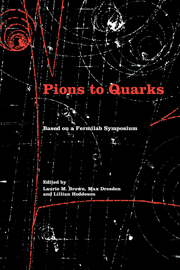Book contents
- Frontmatter
- Contents
- List of contributors
- Foreword by Leon M. Lederman
- Editors' acknowledgments
- Photographs of the symposium
- List of abbreviations
- List of notation
- I Introduction
- II Particle discoveries in cosmic rays
- III High-energy nuclear physics
- IV The new laboratory
- V The strange particles
- VI Weak interactions
- VII Weak interactions and parity nonconservation
- VIII The particle physics community
- 34 The postwar political economy of high-energy physics
- 35 The history of CERN during the early 1950s
- 36 Arguments pro and contra the European laboratory in the participating countries
- 37 Physics and the excellences of the life it brings
- 38 Social aspects of Japanese particle physics in the 1950s
- IX Theories of hadrons
- X Personal overviews
- Name index
- Subject index
38 - Social aspects of Japanese particle physics in the 1950s
Published online by Cambridge University Press: 07 May 2010
- Frontmatter
- Contents
- List of contributors
- Foreword by Leon M. Lederman
- Editors' acknowledgments
- Photographs of the symposium
- List of abbreviations
- List of notation
- I Introduction
- II Particle discoveries in cosmic rays
- III High-energy nuclear physics
- IV The new laboratory
- V The strange particles
- VI Weak interactions
- VII Weak interactions and parity nonconservation
- VIII The particle physics community
- 34 The postwar political economy of high-energy physics
- 35 The history of CERN during the early 1950s
- 36 Arguments pro and contra the European laboratory in the participating countries
- 37 Physics and the excellences of the life it brings
- 38 Social aspects of Japanese particle physics in the 1950s
- IX Theories of hadrons
- X Personal overviews
- Name index
- Subject index
Summary
Introduction
Japan changed considerably during the decade of the 1950s, and research in science and technology was no exception in this regard. World War II came to an end in August 1945 with the surrender of Japan, which in 1950 was still under occupation by the allied powers. The economic situation was miserable: Inflation was rampant, black markets were thriving, and people were literally starving. However, the morale of theoretical physicists was high, for during the 1940s they had produced the two-meson theory, the super-many-time theory, and the covariant renormalization theory. In 1949, Hideki Yukawa was honored with the Nobel Prize in physics. In contrast to this flourishing theoretical culture, the level of experimental particle and nuclear physics was very depressed. For example, on 23 November 1945, all the cyclotrons in Japan – two at the Institute for Physical and Chemical Research (Riken) in Tokyo, one at Osaka University, and one under construction at Kyoto University – were dismantled by order of the occupation forces, who threw the dismembered parts into the sea (possibly also into a lake). On 30 January 1947, the Far Eastern Committee, which was the organization for policy making of the allied powers in Japan, decided that “all research in Japan of either a fundamental or applied nature in the field of atomic energy should be prohibited.” This prohibition, which obviously put severe restrictions on the resumption of research in nuclear physics, was in force until the peace treaty became effective in 1952.
Over the ten years after the signing of the peace treaty in 1952, by which Japan recovered its independence, economic conditions improved significantly.
- Type
- Chapter
- Information
- Pions to QuarksParticle Physics in the 1950s, pp. 536 - 548Publisher: Cambridge University PressPrint publication year: 1989
- 4
- Cited by



